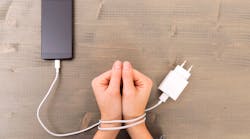Are You Practicing Healthy Digital Behaviors?
Determining what amount of screen time is or isn’t good for you isn’t a simple task. Although some studies or experts claim to have a figure, each person is different in their professional and personal use of digital devices.
The patterns, habits, and feelings, behind our screen use are potentially of more interest than the volume of use. Using screens carefully may be more important than using them less. However long you spend, there are healthier habits and responsible ways to be online that everyone can embrace.
Have you ever actively tried to spend time off the Internet and away from your devices? The idea of a digital detox is an increasingly popular one. In fact, 7 in 10 people have tried to moderate their digital consumption in some way.
In a study by market research consultants GlobalWebIndex, the respondents were divided into:
- Digital Detoxers. People who had detoxed from their digital devices completely for any extended time.
- Digital Dieters. People who had taken steps to cut down the time they spent online or on devices.
- The Digital Comfortable. People who didn’t feel the need to cut down at all.
Interestingly, the things Digital Dieters were working on to cut back their digital consumption included:
- 37% had deleted an app or program in the previous month.
- 35% taken short breaks for hours at a time.
- 27% had limited their digital intake to emails or other routine activities.
- 24% had switched off notifications or emails.
- 23% had moved their phones out of the bedroom.
In another study by telecoms watchdog Ofcom, around a third of people say they feel either cut off (34%) or lost (29%) without the Internet, and 17% say they find that stressful. Half of all adults (50%) say their life would be boring if they could not access the Internet.
But there are also some positive stats. Approximately, 10% feel more productive offline, rising to 15% for 18- to 34-year-olds. And 16% say they feel less distracted when they cut back on their digital consumption.
UNDERSTANDING SCREEN RELIANCE
Without a doubt, we’re in a time where technology use is unprecedented. Thankfully, awareness is growing around certain addictive behaviors that arise as a result of too much screen time.
Screen addiction can happen when screen use is so compulsive it impairs daily functioning. This could be affecting your productivity, relationships, health or wellbeing.
When the WHO added gaming disorder to their list of diseases, they didn’t talk about it in hours of screen time, but rather the impact the hours spent gaming on a screen actually has: "For gaming disorder to be diagnosed, the behavior pattern must be of sufficient severity to result in significant impairment in personal, family, social, educational, occupational or other important areas of functioning and would normally have been evident for at least 12 months."
InvisiLight® Solution for Deploying Fiber
April 2, 2022Go to Market Faster. Speed up Network Deployment
April 2, 2022Episode 10: Fiber Optic Closure Specs Explained…
April 1, 2022Food for Thought from Our 2022 ICT Visionaries
April 1, 20223 BEHAVIORS
In general, 3 behaviors can help you identify whether you may be becoming addicted to your device:
- CRAVINGS. Do you want to look at your devices, sometimes at the expense of other activities? That’s a craving.
- TOLERANCE. Do you increasingly need to spend more time on your phone? If your screen usage is going up, your tolerance is going up. You need more time to get the same fulfilment as before.
- WITHDRAWAL. Do you feel a change in your mood for the worse when you can’t use your device? People can feel agitated, sad, or even angry, when their phones are not available.
Asking these questions isn’t supposed to make you feel bad about yourself. Addiction is a very charged word, and there are plenty of reasons your screen use may be higher than usual — especially during the current COVID-19 situation or if you work using a screen.
Try not to compare yourself with others, but instead focus on how your screen time makes you feel, and how you feel without it.
SCREEN RELIANCE REASONS
There are 3 reasons we tend to use screens more than we believe is healthy:
1. OXYTOCIN
Oxytocin is best known as "the love hormone". It’s also primarily a molecule of social connection. How is this relevant to our screen use? Well, oxytocin is triggered when we use social networking apps. Our brains interpret tweeting or messaging as if we’re directing interacting with people we care about. Posting a photo, responding to comments, tweeting people – they can all give us feelings similar to meeting with friends in person.
2. DOPAMINE
Dopamine is another reason we’ve come to somewhat depend on technology. In a social content, any positive social stimuli can result in dopamine being released — almost like a reward. It reinforces the behavior that preceded it, which includes interaction over any screen. Text messages, likes and comments, and notifications — they all have the potential to release dopamine.
The result tends to be short-term, addictive, dopamine-driven feedback loops. If you compulsively check for notifications, it’s because most apps use variable reward schedules optimized to encourage you to stay engaged. We perceive the reward to be delivered at random, and we end up checking habitually — almost in the same way a slot machine works.
3. CORTISOL
Cortisol is known as the fight-or-flight hormone. It’s what lets you know when you’re in potential danger. But if you’re the type of person who regularly (say, every 15 minutes or so) checks your phone, putting it down can trigger a release of cortisol. When we don’t have an alert or notification every time we check our phones, so our brain starts to wonder about checking. To get rid of the anxious feeling that cortisol gives you, you pick up your phone to see if anything has happened.
BEGINNING TO MAKE CHANGES
Putting down the phone doesn’t shut off your brain. The effects of using our devices and staring at screens don’t stop when we stop. But as we learn more about what’s going on in our heads when we use digital devices, we can reflect on our usage and start to change how they make us feel. We can actively try to create situations where we don’t need our devices.
Are you now wondering whether you’re spending too much time on your device?
Signs you may have a problem include if it’s:
- interfering with your work or school life
- become a negative in your relationships
- encouraging you to sit around more
- affecting your sleep
- making you feel anxious or unhappy
When we use devices, we often find ourselves in a cycle. Any negative feelings associated with not using a device normally vanish when we pick them up again. So we keep repeating the behavior.
It takes some commitment, but it is possible to tackle some of the main issues associated with excessive digital use. But remember that it can take anything between a few weeks to many months to form new habits — so keep persisting.
So what should you do? Start by:
- Using technology to your advantage and set time limits on certain apps. After you’ve used up your daily allowance, you won’t be able to use them anymore.
- Have a conversation about boundaries with your friends or family. Agree on when devices should be off limits so that everyone can be present. A good example of this would be mealtimes.
- Make sure you’ve organized enough fun activities which don’t require a device. Whether it’s physical activity or spending time with friends, make it hard for you to check your device. Recognize and praise yourself for spending time without a screen.
Notes and Resources
This article contains excerpts from "Guide to screen addictions and responsible digital use". To read the complete report, please visit https://www.comparethemarket.com/broadband/content/screen-usage-guide/.
For more information, visit https://www.comparethemarket.com.








